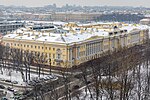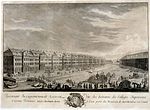Saint Isaac's Bridge

Isaakievsky pontoon bridge (Saint Isaac's Bridge) was the first bridge across Neva river in St.Petersburg, by then the capital of Russian Empire. It was first constructed in 1727. Starting from 1732 it was rebuilt each summer for a period 184 years. The bridge was named after the nearby Saint Isaac's Cathedral. Between 1856 and 1912 construction was shifted to the spot of today's Palace Bridge. The gale of 1733 shattered the bridge, sinking the barques supporting it. After this the bridge was supported by special-design heavy-duty pontoons. In 1916 a passing tugboat sent a spark that caused a fire on the wooden structures and the bridge perished in flames. The former construction spot of the bridge is distinguished today by bank abutments fettled with granite steps leading down to the water.
Excerpt from the Wikipedia article Saint Isaac's Bridge (License: CC BY-SA 3.0, Authors, Images).Saint Isaac's Bridge
Angliyskaya Embankment, Saint Petersburg
Geographical coordinates (GPS) Address Nearby Places Show on map
Geographical coordinates (GPS)
| Latitude | Longitude |
|---|---|
| N 59.938107 ° | E 30.300127 ° |
Address
Сенатская пристань
Angliyskaya Embankment
191011 Saint Petersburg (Адмиралтейский округ)
Saint Petersburg, Russia
Open on Google Maps











